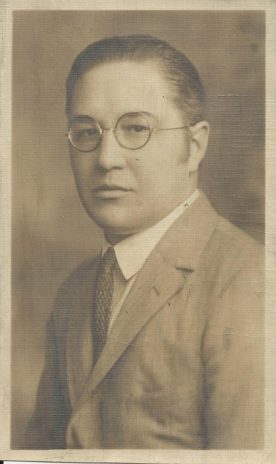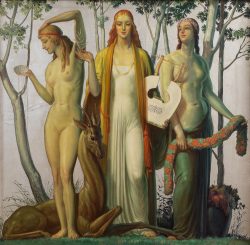Louis Grell, from a photograph, circa 1922, courtesy the Louis Grell Foundation.

Louis Grell 1887–1960
Growing up in Council Bluffs, Iowa, Louis Frederick Grell III showed an early aptitude for art. His parents sent him to live with relatives in Hamburg, Germany, where he attended the School of Applied Arts. While still a student there, he worked on mural projects and exhibited his easel paintings. Back in the US at age nineteen in 1907, Grell undertook an important commissioned mural in Salt Lake City, the proceeds of which enabled him to return to Germany. While attending the Royal Academy of Fine Arts in Munich and the University of Munich, Grell was a member of the American Artists Club, whose members included several young artists with ties to Chicago and the Art Institute. Grell traveled for two years throughout Europe, leaving a few months after the outbreak of World War I.
Grell created stage sets in New York and then in 1916 settled in Chicago with a teaching position at the Chicago Academy of Fine Arts (where his students included the young Walt Disney). His years there were interrupted for military service in 1918, which he spent mostly at Fort Vancouver, Washington. Beginning in 1917, he exhibited easel paintings and won awards in the Art Institute’s annual exhibitions and at many other local and national venues. He also undertook commercial work, including book illustration. From 1922 to 1934, Grell taught poster and advertising design and commercial art at the Art Institute of Chicago. In the 1940s he was again teaching at the Academy of Fine Arts. Grell was a longtime resident of the Trees Studios on Chicago’s Near North Side; fellow tenant Macena Barton is said to have modeled for him.
Mural painting, however, was the mainstay of Grell’s career. He painted possibly his first mural in Chicago as early as 1917, and over the next four decades developed a national reputation with his complete decorative painting programs and individual murals created for theaters, hotels, churches, government buildings, banks, railroad stations, and other kinds of interiors across the country. Among his best-known projects is the now-restored Chicago Theatre, which he decorated lavishly in 1921 and redecorated in 1933 when the theater was renovated. Whether in easel painting or large-scale work, Grell was an adaptable designer who could paint a wide variety of subjects: “From Spanish to Egyptian, to him is but a step, and from searching portraiture to historic pageantry but a change of view,” noted one writer.i His work in easel painting ranged from portraits and historical and religious scenes to elaborate fantasy landscapes and figure paintings. Pictured in photographs wearing a suit and tie while painting, Grell took a businesslike attitude toward his work, once claiming that “success in art is 90 percent hard work.”ii His paintings’ firmly modeled figures, bright tints, and clearly articulated narrative content satisfied the conservative tastes of developers creating lavish “palaces for the people” during a golden age of American popular entertainment.
Wendy Greenhouse, PhD
i Maude I. G. Oliver, “Educating the Poster Artist,” The Poster: The National Journal of Outdoor Advertising and Poster Art 17 (Aug. 1926): 17.
ii “Grell Says Success in Art in 90 Percent Hard Work,” Council Bluffs Nonpareil, undated clipping, after 1944, Louis Grell Foundation files, courtesy of Richard Grell.
